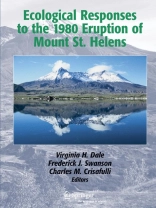Recon?guring Disturbance, Succession, and Forest Management: The Science of Mount St. Helens When Mount St. Helens erupted on May 18, 1980, it did more than just recon?gure a large piece of Cascadian landscape. It also led to dramatic revisions in our perspectives on disturbances, secondary succession, and forestry practices. The Mount St. Helens landscape turned out to be a far more complex place than the “moonscape” that it initially appeared to be. Granted, a large area was literally scoured and sterilized, and that vast expanse of newly formed rock, mud?ows, and avalanche debris up and down the mountain made the Mount St. Helens landscape unique. But I still remember my surprise when, as I stepped out of the helicopter on ?rst landing within the extensive “devastated zone, ” I saw hundreds of plants pushing their way up through the mantel of tephra. Surviving organisms were stunning in their diversity, abundance, and the mechanisms by which they survived. They persisted as whole organisms living below ground, encased within late-persisting snowbanks, and buried in lake and stream sediments. They survived as rhizomes transported along with the massive landslide that accompanied the eruption and as stems that suffered the abrasion of mud?ows. Mud?ows ?oated nurse logs covered with tree seedlings and then redeposited them on the ?oor of a forested river terrace. Millions, perhaps billions, of plants survived as rootstocks and rhizomes that pushed their way up through the tephra, and others survived on the bases of uprooted trees.
Mục lục
Disturbance, Survival, and Succession: Understanding Ecological Responses to the 1980 Eruption of Mount St. Helens.- Geological and Ecological Settings of Mount St. Helens Before May 18, 1980.- Physical Events, Environments, and Geological—Ecological Interactions at Mount St. Helens: March 1980–2004.- Survival and Establishment of Plant Communities.- Plant Responses in Forests of the Tephra-Fall Zone.- Plant Succession on the Mount St. Helens Debris-Avalanche Deposit.- Geomorphic Change and Vegetation Development on the Muddy River Mudflow Deposit.- Proximity, Microsites, and Biotic Interactions During Early Succession.- Remote Sensing of Vegetation Responses During the First 20 Years Following the 1980 Eruption of Mount St. Helens: A Spatially and Temporally Stratified Analysis.- Survival and Establishment of Animal Communities.- Arthropods as Pioneers in the Regeneration of Life on the Pyroclastic-Flow Deposits of Mount St. Helens.- Posteruption Arthropod Succession on the Mount St. Helens Volcano: The Ground-Dwelling Beetle Fauna (Coleoptera).- Causes and Consequences of Herbivory on Prairie Lupine (Lupinus lepidus) in Early Primary Succession.- Responses of Fish to the 1980 Eruption of Mount St. Helens.- Amphibian Responses to the 1980 Eruption of Mount St. Helens.- Small-Mammal Survival and Colonization on the Mount St. Helens Volcano: 1980–2002.- Responses of Ecosystem Processes.- Mycorrhizae and Mount St. Helens:Story of a Symbiosis.- Patterns of Decomposition and Nutrient Cycling Across a Volcanic Disturbance Gradient: A Case Study Using Rodent Carcasses.- Lupine Effects on Soil Development and Function During Early Primary Succession at Mount St. Helens.- Response and Recovery of Lakes.- Lessons Learned.- Ecological Perspectives on Management of the Mount St. Helens Landscape.- Overview of Ecological Responses to the Eruption of Mount St. Helens: 1980–2005.
Giới thiệu về tác giả
Virginia Dale is a Corporate Fellow in the Environmental Sciences Division at Oak Ridge National Laboratory. She is also an adjunct faculty member in the Department of Ecology and Evolutionary Biology at the University of Tennessee.
Fred Swanson is a Research Geologist at the USDA Forest Service Pacific NW Research Station in Corvallis, OR.
Charles Crisafulli is an Ecologist at the USDA Forest Service Pacific Northwest Research station in Olympia, WA.












